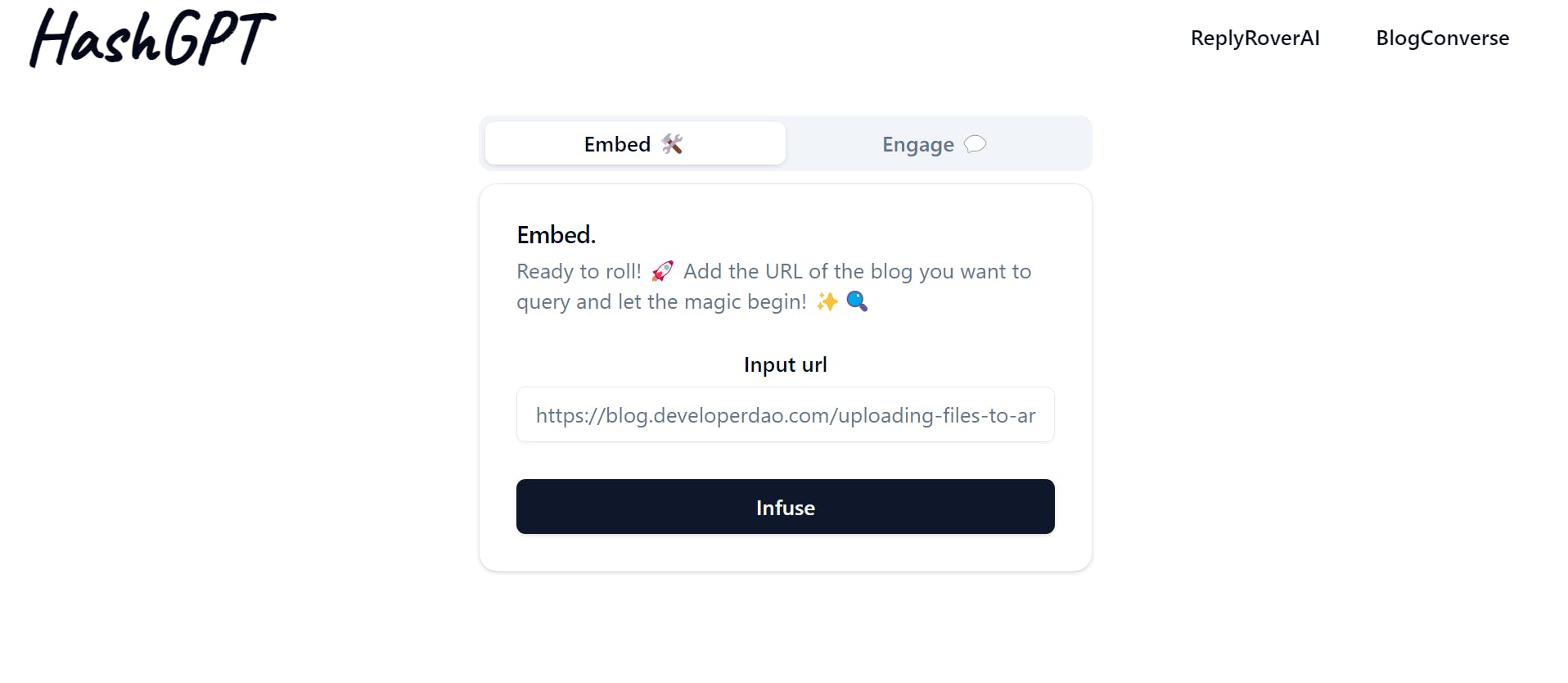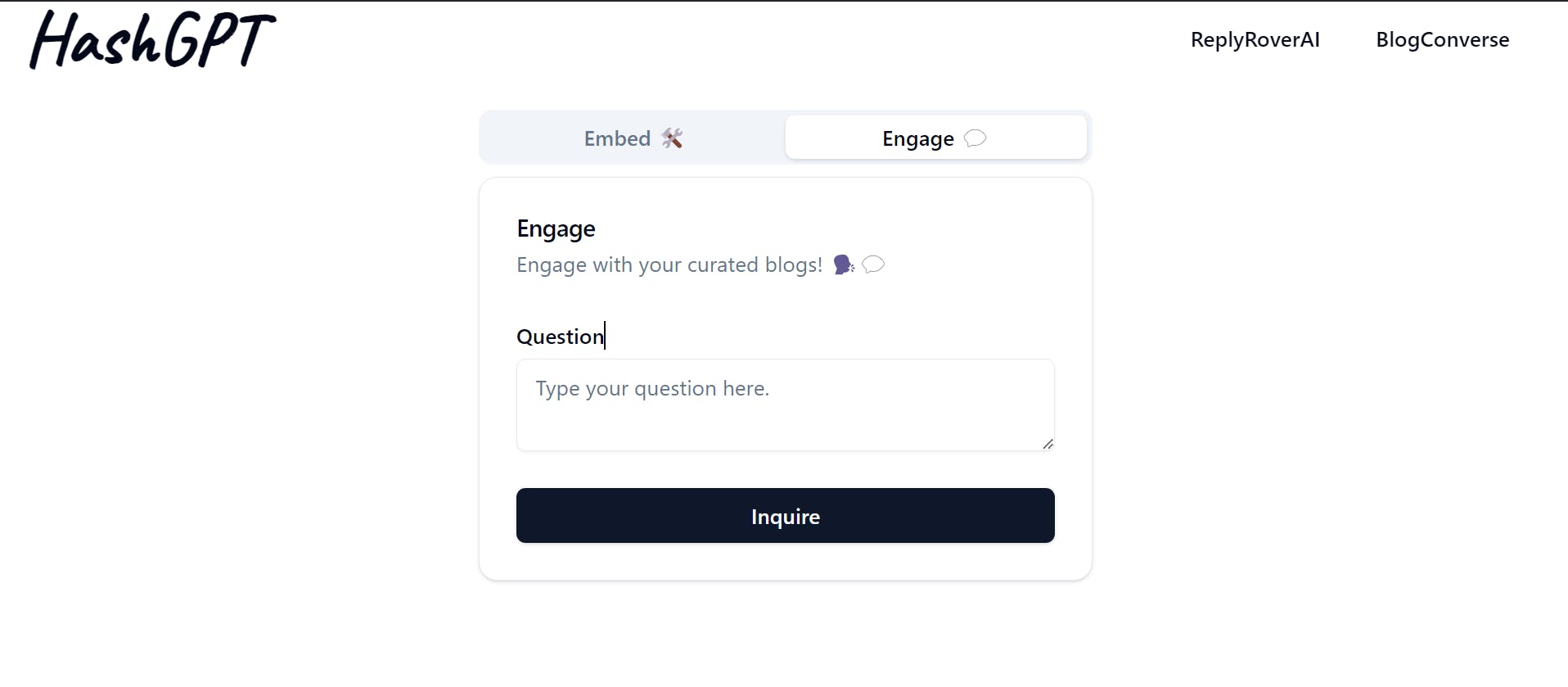Step into a realm where every Cyber exchanges unfolds on a fresh page
HashGPT isn't your typical tool; it's the whisperer behind your blog—an AI sidekick that makes understanding and interacting with a blog a breeze. This post takes you on a journey into the essence of HashGPT, where it paves the way for a seamless connection with Hashnode blogs
Intriguingly, HashGPT doesn't stop at just one blog. Imagine a space where anyone can effortlessly engage with any blog, breaking down communication barriers. Additionally, HashGPT introduces a Comment Concierge, poised to aptly respond to comments on your blog. This means your readers can connect, inquire, and discuss, all while enjoying the convenience of a thoughtful AI sidekick.
Let's jump right into the user flow
Login / Signup

BlogConverse
Connect with any HashNode blog effortlessly. 🌐 Your go-to space for seamless conversations and limitless interaction with diverse blogs.
Step 1 : Embed
Just toss in the blog's URL and give the 'Infuse' button a tap– voila, you're linked up with the blog

Step 2 : Engage
Fire away your questions and ignite the answers! 💥🔍 Hit the 'Inquire' button to unravel the knowledge waiting within the document


ReplyRover AI🚀
Introducing ReplyRover AI – your ultimate blogging sidekick on HashNode! Picture this: whenever someone drops a question in your blog's comments, ReplyRover AI leaps into action, delivering swift and smart replies. - you and your trusty sidekick, ReplyRover AI
Setting up your Comment Concierge 🛠️
Just drop in your blog name, secret API key, and hit deploy🚀✨ Let your AI sidekick work its charm! 🤖✨

ReplyRover AI in action:


Time to plunge into the tech realm🚀✨
Tech stack used :
Next Js
Mongo DB
Weaviate (vector DB)
Fast API
How do we retrieve answers from the blog and generate responses?
Step 1 : Text Preprocessing
This step involves breaking the blog into chunks of sentences. Additionally, it includes importing necessary modules, with haystack being a crucial component
import nltk
from haystack.document_stores import WeaviateDocumentStore
from haystack.nodes import EmbeddingRetriever
from haystack.nodes import PromptNode, PromptTemplate, AnswerParser, BM25Retriever
from haystack.pipelines import Pipeline
from nltk.tokenize import sent_tokenize
nltk.download('punkt', quiet=True)
def split_into_sentences(text):
sentences = sent_tokenize(text)
return sentences
Step 2 : Create List of Documents
A list of dictionaries representing documents is created, each containing the sentence content and its index.
documents = [{"content": sentence, "meta": {"sentence_index": i}} for i, sentence in enumerate(sentences, 1)]
Step 3 : Weaviate Document Store Initialization
an instance of the Weaviate Document Store is initialized.The 'index' parameter is set to the username, allowing for efficient organization and retrieval of documents associated with that specific user. This ensures a structured and user-centric approach to managing information within the Weaviate
# Weaviate Document Store Initialization
ds = WeaviateDocumentStore(host="http://localhost", port=8080, embedding_dim=768, index=username)
# Creating a Collection by Specifying the Index
ds.write_documents(documents)
Step 4 : Embedding Retriever Initialization
The EmbeddingRetriever is initialized with the Weaviate Document Store and Sentence Transformer model, and embeddings in the document store are updated.
retriever = EmbeddingRetriever(document_store=ds, embedding_model="sentence-transformers/multi-qa-mpnet-base-dot-v1")
ds.update_embeddings(retriever)
Step 5 : Prompt Template Definition
A prompt template is defined with a specific structure and an output parser for processing the model's responses
eg. prompt templates
prompt_template = PromptTemplate(
prompt=""" ... """,
output_parser=AnswerParser(),
)
Step 6 : Prompt Node Initialization
A Prompt Node is created with the GPT-3.5-turbo-instruct model, OpenAI API key, and the defined prompt template.
prompt_node = PromptNode(
model_name_or_path="gpt-3.5-turbo-instruct", api_key=openai_api_key, default_prompt_template=prompt_template
)
Final Step : Pipeline Setup and execution
The code orchestrates a seamless process by configuring a pipeline that integrates both retriever and prompt node components. This pipeline efficiently retrieves information from a Weaviate document store and generates responses to a user's query using the GPT-3.5-turbo-instruct model. By blending retriever and generative approaches, it ensures a comprehensive and accurate response. Finally, the pipeline is executed with the provided query, completing the loop for a sophisticated and effective information retrieval system
generative_pipeline = Pipeline()
generative_pipeline.add_node(component=retriever, name="retriever", inputs=["Query"])
generative_pipeline.add_node(component=prompt_node, name="prompt_node", inputs=["retriever"])
response = generative_pipeline.run(query)
resources :Embedding Retrieval , Generative QA
Video demo 🎬:
github link....
Future improv..
While building, I dreamt of more; alas, time played the constraint card. Here's what I couldn't squeeze in!
an AI agent with contextual awareness of previous replies or chats for seamless and coherent conversations
Reply Rover AI, tailored to navigate and extract insights exclusively from selected documents
ReplyRover AI, to distinguish between regular comments and questions
Conclusion
As I conclude this blog, I've traversed numerous challenges, acquiring invaluable insights into the realms of frontend, backend, and AI. With a touch of excitement, I anticipate taking this project to new heights. The features implemented serve as a blueprint for enhancing user experience and engagement.
Finally, I express my thanks to Hashnode for the wonderful opportunity to build something with their APIs.


